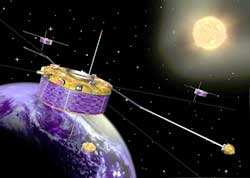
Studying the Sun-Earth connection
BY PETER BOND
ASTRONOMY NOW
Posted: July 14, 2000
| |

The four Cluster spacecraft will study how the Sun affects the Earth and its environment. Image: ESA.
|
One piece of good fortune arising from the tragic loss of the first Cluster satellites has been the shift in the launch date. By launching Cluster II in the summer of 2000, the satellites will be able to study the interaction between the solar wind and the Earth at a time when the Sun is at its most active.
Scientists will be given a grandstand seat at the peak of the battle between the charged particles thrown out by our neighbourhood star and the Earth's protective magnetic shield.
As the satellites orbit the Earth, they will be able to investigate the rapid changes which occur in the magnetosphere when large numbers of electrically charged particles (electrons and protons) in the solar wind arrive at our planet.
Interplanetary shoot out
"It is like a never-ending football game," said Cluster II project scientist, Philippe Escoubet. "The Sun is kicking particles like balls. The Earth is the goal and its magnetic field is the goalkeeper. It's always trying to push the balls away, but some get past. When particles score goals, they disturb the Earth's environment. Sometimes the Sun is very quiet, but when it's very active we get a lot of balls coming."
| |

The Cluster spacecraft keep watch over the Sun's effects on Earth. Image: ESA.
|
"Cluster II will give us the best information yet on how the Sun affects the near-Earth environment," he explained. "For the first time we will be able to study the Earth's magnetic field from four viewpoints, like having four cameras at a football match -- one behind the goal and three others at different angles.
"This is the first time this has been done for the Earth's magnetic field. This is very exciting because it will give us a much better understanding of the space environment which surrounds our planet."
After the utter despair of four years ago, scientists and engineers at the European Space Agency can now look forward to a new era in the study of our planet and its location in space.

|
 |
 |
 |
Pre-launch briefing
 Cluster to rise from the ashes Cluster to rise from the ashes

 Anatomy of a Cluster II spacecraft Anatomy of a Cluster II spacecraft

 Into orbit Into orbit

 Unique 3-D science Unique 3-D science

 Studying the Sun-Earth connection Studying the Sun-Earth connection


Video vault
 Animation depicts the launch of a pair of Cluster 2 satellites aboard a Starsem Soyuz equipped with a Fregat upper stage.
Animation depicts the launch of a pair of Cluster 2 satellites aboard a Starsem Soyuz equipped with a Fregat upper stage.
PLAY (352k, 30sec QuickTime file)

 The first quartet of Cluster satellites is destroyed when Europe's Ariane 5 explodes soon after launch on June 4, 1996.
The first quartet of Cluster satellites is destroyed when Europe's Ariane 5 explodes soon after launch on June 4, 1996.
PLAY (216k, 18sec QuickTime file)

Download QuickTime 4 software to view this file.




|

